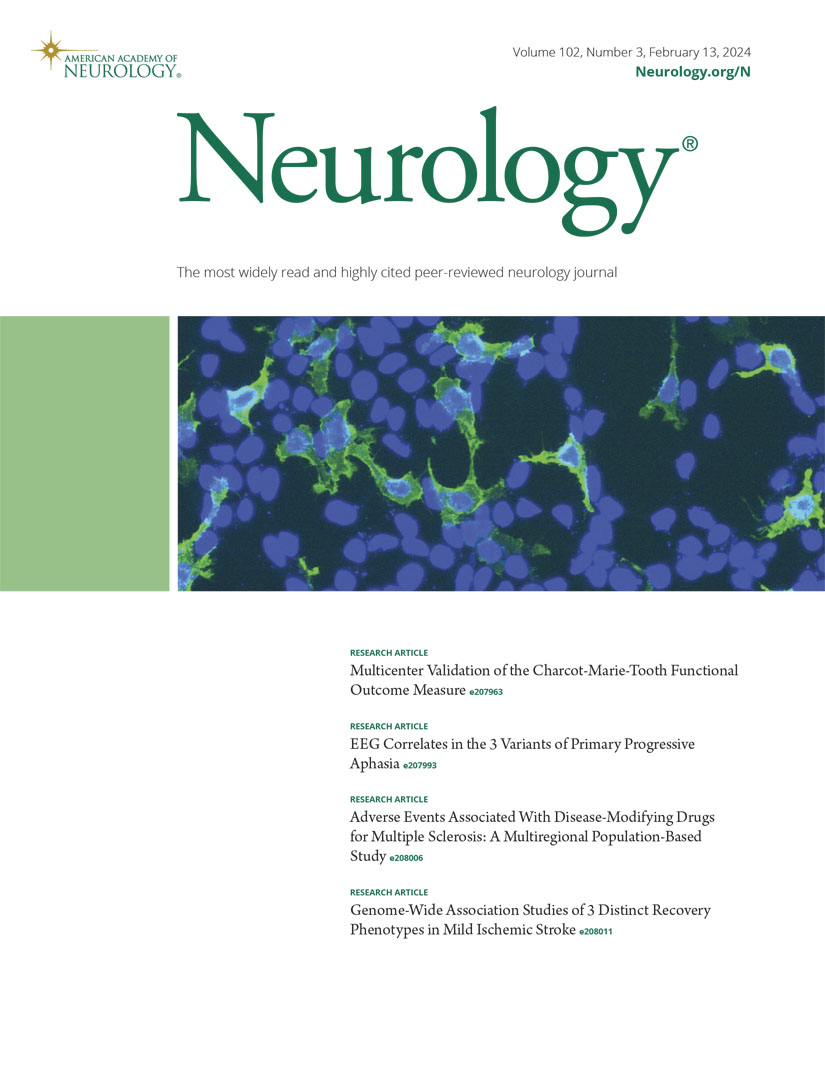Long-Term Fatigue Following Transient Ischemic Attack: A Prospective Cohort Study.
IF 7.7
1区 医学
Q1 CLINICAL NEUROLOGY
引用次数: 0
Abstract
BACKGROUND AND OBJECTIVES By definition, patients with transient ischemic attack (TIA) should not have residual symptoms beyond 24 hours. However, preliminary evidence indicates lasting challenges such as fatigue. It is unknown who develops fatigue, and the extent. This knowledge is required to develop evidence-based support for patients. We aimed to explore fatigue up to 12 months after TIA and determine what characterizes patients who experience pathologic fatigue. METHODS This is a prospective cohort study including patients with TIA diagnosed at a specialized stroke unit. Fatigue was measured using Multidimensional Fatigue Inventory (MFI-20) and Fatigue Severity Scale at 14 days (baseline) and 3, 6, and 12 months after discharge. The association between candidate prognostic factors and fatigue at 12 months was tested using linear regression models. We compared model performances using likelihood ratio (LR). RESULTS We included 354 patients, of which 287 provided baseline responses (mean age 70.0 ± 11.1, 42.5% female). At baseline and 3, 6, and 12 months, the mean level of general fatigue on MFI was 12.3 ± 4.6, 11.9 ± 4.6, 11.4 ± 4.5, and 11.1 ± 4.5 and the proportion with pathologic fatigue (≥12 on the MFI-20 General Fatigue) was 61.3%, 53.5%, 54.0%, and 53.8%, respectively. The prevalence of acute infarction was evenly distributed between patients who reported fatigue and those who did not. Previous anxiety/depression was twice as common in the group that reported fatigue. The model including baseline level of fatigue, sex, age, and acute infarction was able to explain variability in the reported data to a statistical significantly higher extent, compared with the model only including sex, age, and acute infarction (p < 0.001, LR = 387.30). DISCUSSION Pathologic fatigue is common up to 12 months after TIA diagnosis. If patients report fatigue within 14 days after discharge, it is likely that this remains until 12 months. We found no indication of an association between the presence of acute ischemic lesions and fatigue. The prevalence of previous anxiety/depression was higher in the group that reported fatigue. TRIAL REGISTRATION INFORMATION The study is part of the Life After Stroke Cohort (ClinicalTrials.gov: NCT05234528). Registered February 1, 2022. First patient included February 2, 2022.短暂性脑缺血发作后的长期疲劳:一项前瞻性队列研究。
背景与目的根据定义,短暂性脑缺血发作(TIA)患者的症状不应超过24小时。然而,初步证据表明,疲劳等长期挑战。目前尚不清楚谁会产生疲劳,以及疲劳的程度。这些知识是为患者提供循证支持所必需的。我们的目的是探索TIA后12个月的疲劳,并确定经历病理性疲劳的患者的特征。方法:这是一项前瞻性队列研究,包括在专门卒中单位诊断的TIA患者。在出院后14天(基线)、3、6和12个月,使用多维疲劳量表(MFI-20)和疲劳严重程度量表测量疲劳程度。使用线性回归模型检验候选预后因素与12个月时疲劳之间的关系。我们使用似然比(LR)比较模型的性能。结果纳入354例患者,其中287例提供基线反应(平均年龄70.0±11.1岁,42.5%为女性)。在基线和3、6、12个月时,MFI一般疲劳的平均水平分别为12.3±4.6、11.9±4.6、11.4±4.5和11.1±4.5,病理性疲劳(MFI-20一般疲劳≥12)的比例分别为61.3%、53.5%、54.0%和53.8%。急性梗死的患病率在报告疲劳的患者和没有报告疲劳的患者之间分布均匀。先前的焦虑/抑郁在报告疲劳的小组中是两倍。与仅包含性别、年龄和急性梗死的模型相比,包含疲劳基线水平、性别、年龄和急性梗死的模型能够在统计上显著更高的程度上解释报告数据中的变异性(p < 0.001, LR = 387.30)。病理性疲劳常见于TIA诊断后12个月。如果患者在出院后14天内报告疲劳,这种情况可能会持续到12个月。我们没有发现急性缺血性病变和疲劳之间存在关联的迹象。先前焦虑/抑郁的患病率在报告疲劳的组中更高。试验注册信息:该研究是卒中后生活队列(ClinicalTrials.gov: NCT05234528)的一部分。注册日期:2022年2月1日。第一位患者于2022年2月2日入选。
本文章由计算机程序翻译,如有差异,请以英文原文为准。
求助全文
约1分钟内获得全文
求助全文
来源期刊

Neurology
医学-临床神经学
CiteScore
12.20
自引率
4.00%
发文量
1973
审稿时长
2-3 weeks
期刊介绍:
Neurology, the official journal of the American Academy of Neurology, aspires to be the premier peer-reviewed journal for clinical neurology research. Its mission is to publish exceptional peer-reviewed original research articles, editorials, and reviews to improve patient care, education, clinical research, and professionalism in neurology.
As the leading clinical neurology journal worldwide, Neurology targets physicians specializing in nervous system diseases and conditions. It aims to advance the field by presenting new basic and clinical research that influences neurological practice. The journal is a leading source of cutting-edge, peer-reviewed information for the neurology community worldwide. Editorial content includes Research, Clinical/Scientific Notes, Views, Historical Neurology, NeuroImages, Humanities, Letters, and position papers from the American Academy of Neurology. The online version is considered the definitive version, encompassing all available content.
Neurology is indexed in prestigious databases such as MEDLINE/PubMed, Embase, Scopus, Biological Abstracts®, PsycINFO®, Current Contents®, Web of Science®, CrossRef, and Google Scholar.
 求助内容:
求助内容: 应助结果提醒方式:
应助结果提醒方式:


